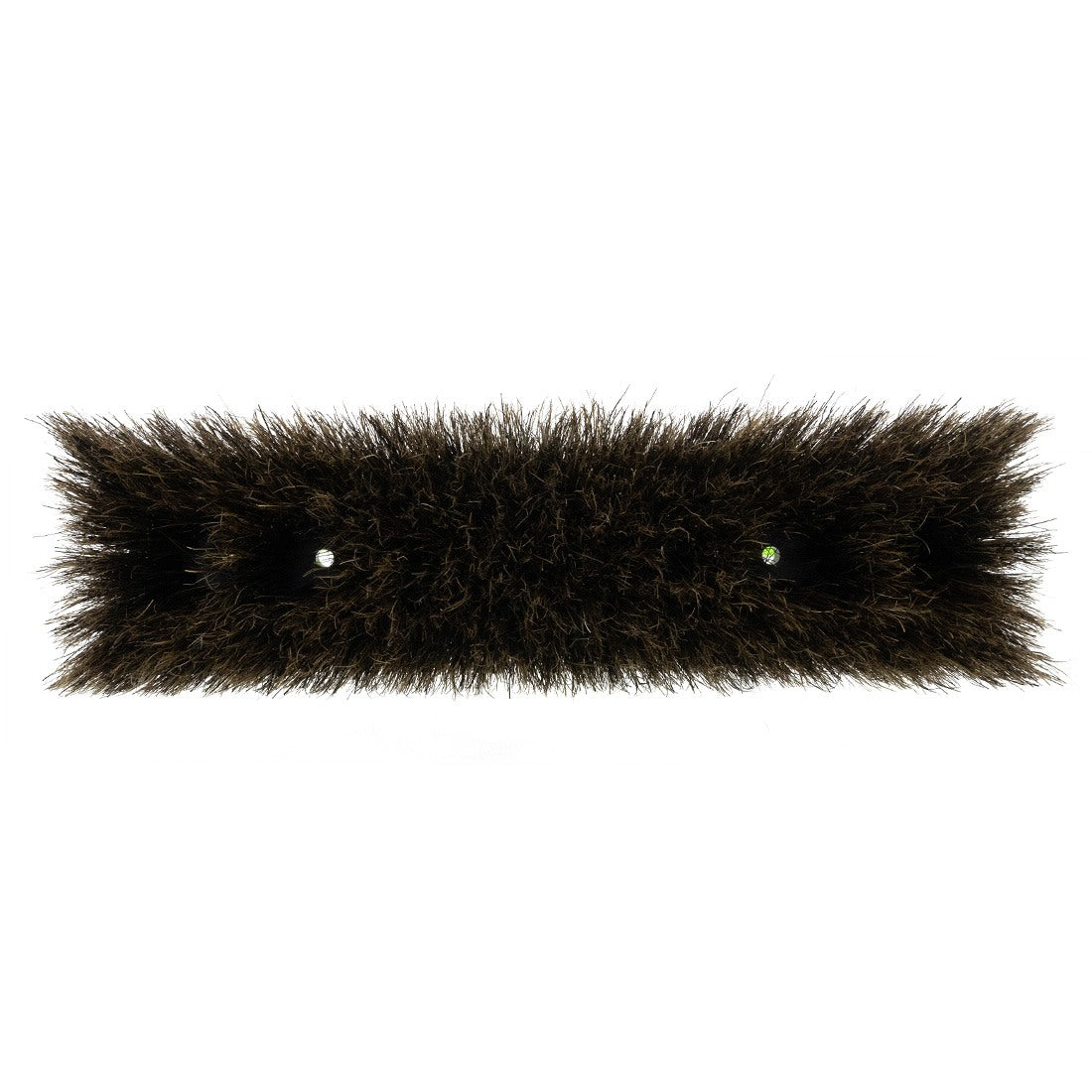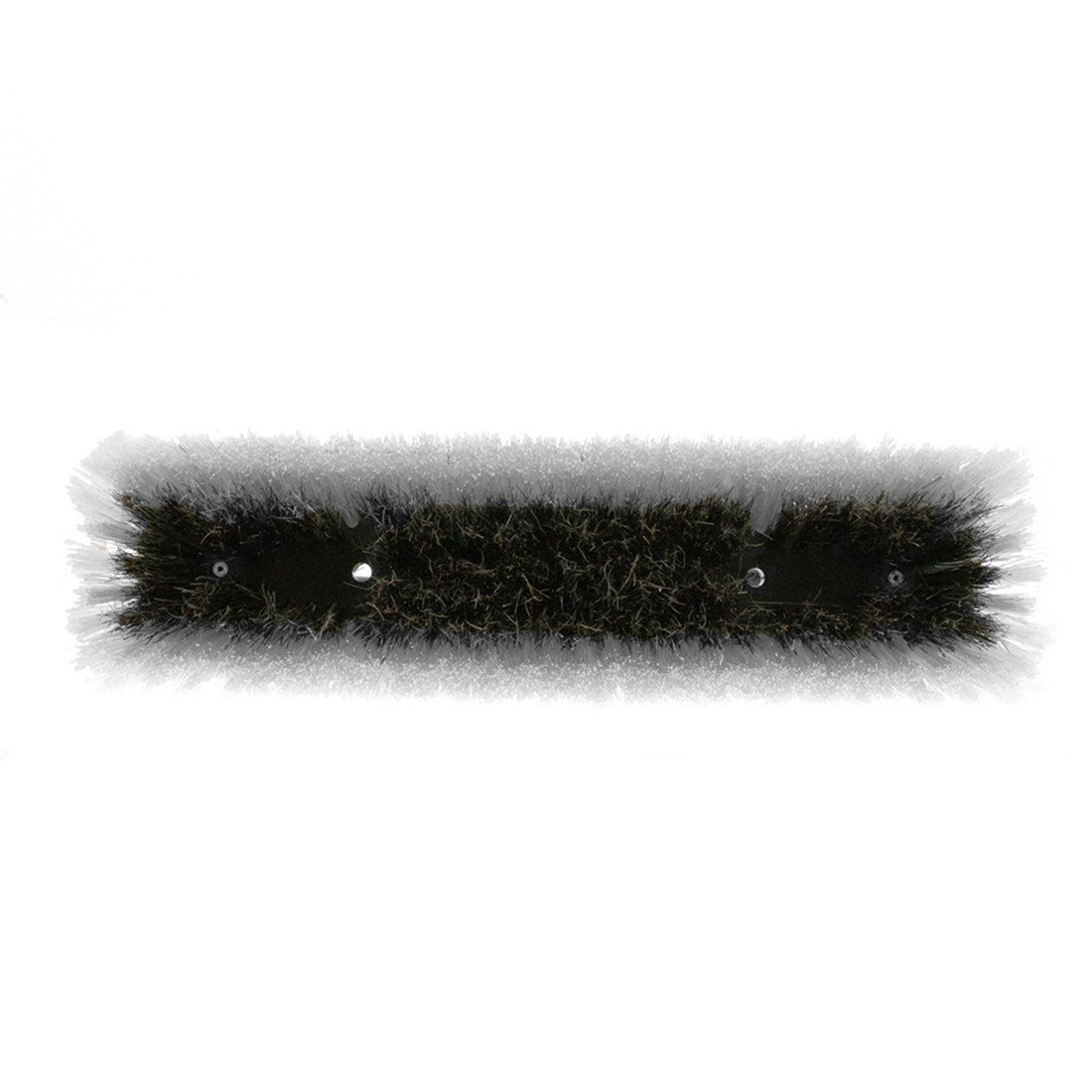A water fed brush attaches to a water fed pole to scrub and clean your windows. You’ll find window cleaners with pure water systems using this method for it’s speed and efficiency at leaving spotless windows. Once the glass is soaked, the cleaner can scrub dirt and grime with the brush’s bristles, no soap needed, all while a continuous flow of purified water rinses it away.
In this week’s Window Cleaner University article, we’re going to talk all about what a water fed brush is and how you can add it to your window cleaning arsenal for the best results possible.
Bristles: Natural or Artificial
When it comes to water fed brushes, there are three main bristle types: boar’s hair, nylon, or a combination of the two called hybrid. Most modern brushes feature a dual-trimmed design, meaning the outer bristles are longer, so when pressed down against the glass, they splay out, enabling them to cover more surface area. The inner bristles are shorter, so they can scrub dried-on dirt.
- Boar’s hair is best on lower windows because it gets heavy. It requires the least amount of pressure while cleaning and is the most aggressive option for windows that need a whole lot of TLC.
- Nylon is best on higher windows because it is lightweight. Water and dirt easily run through it, as it is not porus. The most pressure is required when cleaning with nylon.
- Hybrid brushes, the most versatile and popular option of the bunch, are optimal for moderately dirty windows. These brushes have nylon bristles on the outside for better move ability and boar’s hair on the inside for better scrubbing power.

Boars Hair |

Nylon |

Hybrid |
Boar’s Hair

The most aggressive of all the brushes is the boar’s hair. Boar’s hair bristles are natural and come from a domesticated boar. These hairs are coarse, yet flexible and soft enough to scrub glass without scratching it. You
will want to lift it away from the window to rinse off the debris you agitated up from the glass. A boar’s hair brush tends to get heavy and weighed down while
used because it is a natural fiber and absorbs water. We recommend using a boar’s hair on windows that are under 35 feet. Otherwise, it can drag from being too heavy and hard to maneuver properly.
Our Recommendation:

Nylon
On the other side of the spectrum, we have nylon brushes. Nylon brushes are stiffer than the boar’s hair, allowing the brush to glide along the glass more smoothly and dirt and debris to rinse through it faster. They are also better to use on higher windows as they aren’t porous like the boar’s hair and won’t absorb water.
Our Recommendation:
Hybrid

If you want to use the best of both worlds, a hybrid brush will be your top choice. These brushes utilize nylon bristles on the outer trim and boar’s hair on the inner. This makes the brush’s glide silky smooth, while offering the superior scrubbing power of the boar’s hair in the center.
[Insert Picture/Video left or right aligned within above text]
Our Recommendation:
Blocks:
Water fed brush blocks come in a variety of sizes, from 10 inches to 23 inches, with their splay, also known as how far their bristles reach when pushed down, generally extending to 2 inches. For example, if you have a 10-inch brush, its splay will generally allow for cleaning up to 12 inches of surface area. The size of the block you choose will depend on the type of job site you're working on, whether it's solar panel cleaning, residential window cleaning, or commercial window cleaning.
- 10-inch blocks are ideal for residential jobs with small to medium-sized windows.
- 14-inch blocks are ideal for commercial jobs with medium to large-sized windows.
- 18-inch blocks are ideal for commercial jobs with large to very large windows.
- 20 to 23-inch blocks would be most suitable for solar panel cleaning.
Water fed brush blocks also come with either single-jetted or dual-jetted configurations. Single-jetted brush blocks have one set of jets. Dual jetted brushes have four total jets, with two on each side.
Jets: Pencil or Fan
Water fed brush jets are small fittings made of durable plastic or metal that are connected to a thin hose to shoot water through their nozzles. They are installed in the brush block, where there are pre-cut holes that they fit into. Generally, there are two kinds of jets for water fed brushes: pencil or fan.
Which type of jet you choose will depend on the type of windows you are cleaning and the amount of dirt and grime present.
- Pencil jets are a good choice for cleaning windows that are heavily soiled or that have a lot of dried-on dirt and grime.
- Fan jets are a good choice for cleaning windows where you need a lot of coverage or are dealing with hydrophobic glass.
Pencil Jets
Pencil jets have a small round hole in the center to shoot out a narrow, powerful stream of water ideal for cleaning areas with dried-on dirt and grime. Their long-reaching stream makes it so the brush does not need to be on the glass during cleaning. Pencil jets are essential when cleaning French panes for aiming into their corners to shoot away dried-on pollen, dirt, and debris. This kind of jet is better when approaching hydrophilic glass, which has an affinity for water.
Fan Jets
Fan jets are more valuable when cleaning with broader strokes than streamlined pencil jets. These nozzles have a long line in the middle of them for releasing wide showers of water to cover the entire pane of glass. These favor coverage over precision. This kind of jet is best for hydrophobic glass, which generally repels water, as the molecules are smaller and can maximize contact with the glass.
Accessories:
There are a number of accessories that you can use with your water fed brush to make your job easier and more efficient. Some common accessories include:
- Rinse Bar: A rinse bar attaches to the brush block and provides a steady stream of water to rinse away dirt and debris.
- Angle Adapter: An angle adapter allows you to adjust the angle at which the brush head meets the window.
- Gooseneck: A gooseneck/extended angle adapter allows you to adjust the angle of the brush and reach over deep ledges, making it easier to clean hard-to-reach areas.
- XERO Fast Lock: The XERO Fast Lock makes it faster to swap brushes, provides a more secure hold, and offers greater flexibility on the job site.
Choosing the Right Water Fed Brush:
Water fed brushes are an essential tool for any window cleaner. By choosing the right brush for the job, you can save time and effort, and get your windows sparkling clean.
When choosing a water fed brush, there are a few things to consider:
- Bristle Type: Choose the bristle type that is best for the type of windows you are cleaning and the amount of dirt and grime present.
- Block Size: Choose a block size that is appropriate for the size of the windows you are cleaning and the type of job site you're working on.
- Jets: Choose the type of jets that are best for the type of windows you are cleaning and the amount of dirt and grime present.
- Accessories: Consider which accessories will make your job easier and more efficient.
Here are some additional tips for choosing and using a water fed brush:
- Be sure to get acquainted with proper technique when using water fed poles. Brushes can vary in how “grippy” they are on a window.
- Keep your brush clean. Keeping your water fed brush clean can help extend the life of your brush and ensure spotless windows.
- When using a water fed brush, be sure to use Pure Water. This allows you to clean without the need for soap and leave windows sparkling.
Still Have Questions?
Don’t sweat it! If there is anything you’re unsure about, want to learn more about, or need advice on, do not hesitate to reach out to us. Window Cleaning Resource is here for you 24/7, with the help of our super-friendly window cleaning experts.
Having owned their own window cleaning business, they have tons of information on window cleaning products, business tips, and more, even if you just want to talk shop.
For product reviews, discussions, information, and more:
Check out our informative YouTube Channel
Get advice, share tips, or just talk shop on our Window Cleaning Community Page
Shop professional-grade window cleaning products and more at WCR!


